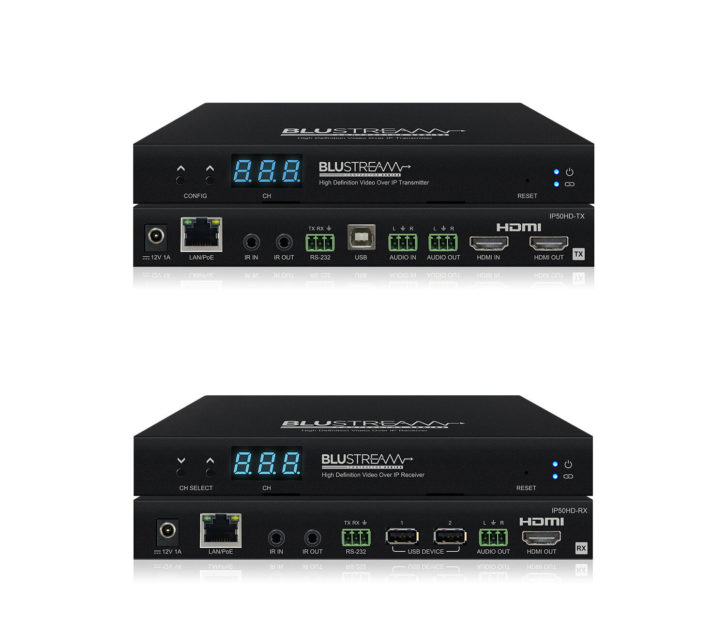
By Jason Fitzgerald
AV distribution as a category consists of five main functions: extension, splitting, switching, matrixing, and conversion. While there are numerous products on the market that can provide any one of these capabilities, most commercial applications involve several. For example, a conference room requires multiple inputs to be switched, converted, and extended. Instead of relying on separate products to achieve this, a far more cost-effective approach is to utilize one solution that delivers all three capabilities. Enter video over IP (VIP) technology. Capable of addressing all five functions, VIP adapts seamlessly to the needs of any vertical market, making it the chameleon of commercial video distribution.
In addition to their multi-functionality, VIP solutions offer a number of other benefits in commercial applications. One of the most important is that they take advantage of existing network infrastructure. With a strong network backbone in place, end users need only invest in a small transmitter for each video source and receiver for each display. Thanks to this modularity, expanding a system is as simple as adding transmitters and receivers as needed.
Compare that to utilizing a fixed HDMI or HDBaseT matrix switcher. A bar with four satellite boxes and 50 displays would need to invest in a 50×50 matrix, to the tune of tens of thousands of dollars. While it would allow for the system to be expanded with an additional 46 video sources — an unrealistic need in this setting — adding a single display will require an upgrade to an ever larger and more expensive matrix. With a VIP solution, the bar’s owners aren’t paying for extra inputs they will never use, and they can easily add another display with only a small investment in a receiver.
VIP also provides more capabilities than HDBaseT in point-to-point installations, including separating audio, video, control, and USB signals and freely routing them individually. With traditional AV distribution solutions, this requires additional equipment to achieve. In addition, VIP provides distance advantages over HDBaseT when fiber-optic networking cable is in place to interconnect building floors and even separate facilities.
With all of these advantages, it’s no surprise that adoption of VIP technology has taken off across all vertical markets. It’s powering video walls for emergency operators in command and control centers; keeping guests entertained on game day in bars and restaurants; enabling digital signage in retail environments to enhance the shopping experience; and streaming live sermons throughout houses of worship. But by far, VIP has made the biggest impact in the corporate and higher education markets, where strong network infrastructures are often already in place. In fact, with increasing demands for data, these networks are becoming even more robust with additional bandwidth of which VIP solutions can take advantage. It’s also important to note that the range of VIP solutions has expanded to cover a wide gamut of needs and price points, from bandwidth-saving H.265 iterations to fully uncompressed solutions when uncompromising fidelity is needed.
In both of these markets, VIP’s scalability provides a level of future-proofing by allowing new features and products to be incorporated into the system by swapping out endpoints. It’s also helping drive innovative applications such as the “agnostic workspace,” in which users simply wave an RFID card in front of a reader on any computer for immediate access to their own desktop. This capability promotes collaboration and a flexible working environment in the office by allowing employees to use any workstation and share their desktop with coworkers without a laptop or flash drive. It’s also a powerful tool in the conference room — dramatically simplifying set-up for non-technical users — and in the classroom, where different teachers utilize the space throughout the day. And of course, the system can be easily expanded with additional users and workstations.
VIP will play an even bigger role in corporate environments in the future with the ongoing need for social distancing. Employees won’t be congregating in large numbers in conference rooms anytime soon. Instead, some will join from their desk or work at home, with the meeting taking place on their desktops or mobile devices. Likewise, some students will continue to learn remotely, at least part-time. To provide these remote capabilities in both markets, VIP solutions will need to interface with software like Zoom, Microsoft Teams, and GoToMeeting; mobile devices; and USB equipment like cameras and microphones. While this can be done today using separate devices, integration with VIP technologies will provide seamless experiences across local and remote platforms.
However, even with all its benefits, VIP hasn’t completely eclipsed other technologies in the commercial space. In fact, many applications are incorporating a mixture of traditional AV distribution equipment and VIP solutions to lower costs. For example, replicating content in digital signage systems whenever possible — using standard HDMI splitters — can reduce endpoint costs at displays. And in smaller conference rooms and similar settings, technologies like HDBaseT are still very relevant. We should know. At Bluestream, we have an extensive offering of HDBaseT solutions to complement our Multicast UHD VIP system, and they’re not going anywhere.
Jason Fitzgerald serves as Product Manager, Video Solutions for Bluestream US, a division of RTI, and award-winning AV distribution solutions provider. He can be reached at [email protected].

Blustream Recently Expanded its Video Over IP Portfolio With New Contractor Series
Contractor Series IP50HD: With essentially no limitation on project size, the new ultra-flexible 1080p transmitter and receiver pair offer unrivalled installation opportunities. They are perfectly suited for a range of commercial applications requiring robust HD video over IP support, such as command and control rooms, digital signage, and workstation management installations. The Blustream Contractor HD Video over IP distribution platform delivers AV and control signals over a 1Gb network. Using the industry-leading Blustream ACM200 control module, the IP50HD boasts simplified integration with third-party control platforms and uses the company’s Drag and Drop TV visual control application, ensuring a seamless experience during installation and for the end user. The IP50HD-TX 1080p HDMI transmitter and the IP50HD-RX 1080p HDMI video scaling receiver use H.265 compression technology to deliver HDMI, as well as bidirectional IR, RS-232, and USB/KVM up to 100 meters over a standard network architecture. The transmitter includes a HDMI loop-out for cascading to multiple devices. Both devices can be powered via PoE from the network switch or locally should the switch not support PoE. With multiple configuration options available, the multicast HD solution is ideal for both residential and commercial installations.











